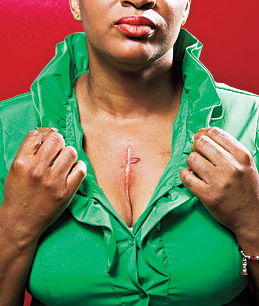
(2 of 2)
In Charles Town, W.Va., Rhonda Monroe, another WomenHeart champion, recently set up at a friend's beauty salon for several hours to tell her story about having her heart attack misdiagnosed five days after the birth of her third child. Monroe, now 42, was 36 at the time and had a hard time convincing doctors that the crushing pain she felt in her chest was not just some postpartum phenomenon. Her story and the question-and-answer session that followed were so compelling, she's been asked back.
But those are merely the first steps. The next phase involves understanding why women experience heart disease in such a gender-specific way and developing tailored treatment strategies. While heart attacks in both men and women are primarily caused by the buildup of atherosclerotic plaques within blood-vessel walls in the heart, these deposits don't always look the same, nor do they occur in the same places. In men, the lesions usually occur in the bigger blood vessels, bulging out into the vessel's cavity. That makes them easy to spot when doctors perform an angiogram or image the heart with scanners.
In women, the accumulation may be more diffuse, spreading out among smaller vessels, which causes the whole artery to appear technically clear, even if it's narrower. Some medications can expose the more restricted function of these vessels, but often cardiologists won't perform additional tests when they don't spot any obvious blockages. "A lot of doctors will see that the vessels look normal and stop," says Dr. Annabelle Volgman, medical director of the Heart Center for Women at Rush University Medical Center in Chicago. Even after a heart attack, the arteries of 30% of female patients still appear to be clear.
Dr. Noel Bairey Merz, medical director of the Women's Heart Center at Cedars-Sinai Medical Center in Los Angeles, is leading a multicenter study seeking the best ways to identify this more insidious form of heart disease. She's also pushing hard to have diagnostic guidelines changed so more physicians know to think about heart disease whenever women complain of pain above the waist.
Despite such knowledge, big challenges remain. The fact that women have not traditionally been included in clinical trials of heart-disease treatments — they make up less than 30% of trial populations — means that an appreciation for how the disease progresses in them has been lost amid the trends appearing in men.
But that's where the WomenHeart champions are hoping to make a difference by serving as resources for their communities, speaking intelligently about their experiences and inspiring more women-specific studies. Hayes' hope is that by the time she retires, specialized centers like hers won't be necessary and that every patient with heart disease will be treated with the best available individualized therapies. "I don't see that happening real soon," she says, recognizing that physicians are just beginning this new approach to research. Then she adds, "But I also have a ways to go before I retire."